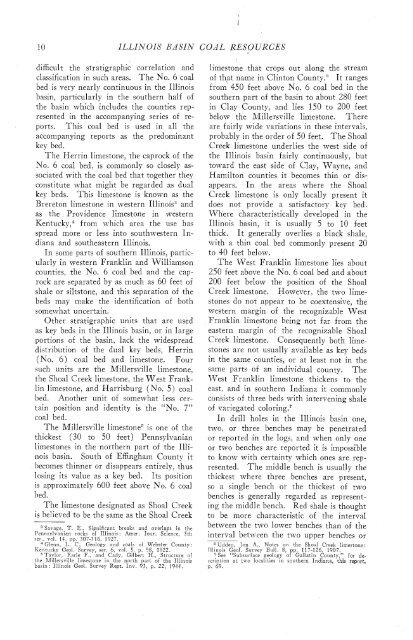subsurface geology and coal resources of the pennsylvanian system ...
subsurface geology and coal resources of the pennsylvanian system ...
subsurface geology and coal resources of the pennsylvanian system ...
You also want an ePaper? Increase the reach of your titles
YUMPU automatically turns print PDFs into web optimized ePapers that Google loves.
10 ILLIN018 BASIN COAL RESOURCES<br />
difficult <strong>the</strong> stratigraphic correlation <strong>and</strong><br />
classification in such areas. The No. 6 <strong>coal</strong><br />
bed is very nearly continuous in <strong>the</strong> Illinois<br />
basin, particularly in <strong>the</strong> sou<strong>the</strong>rn half <strong>of</strong><br />
<strong>the</strong> basin which includes <strong>the</strong> counties represented<br />
in <strong>the</strong> accompanying series <strong>of</strong> reports.<br />
This <strong>coal</strong> bed is used in all <strong>the</strong><br />
accompanying reports as <strong>the</strong> predominant<br />
key bed.<br />
The Herrin limestone, <strong>the</strong> caprock <strong>of</strong> <strong>the</strong><br />
No. 6 <strong>coal</strong> bed, is commonly so closely associated<br />
with <strong>the</strong> <strong>coal</strong> bed that toge<strong>the</strong>r <strong>the</strong>y<br />
constitute what might be regarded as dual<br />
key beds. This limestone is known as <strong>the</strong><br />
Brereton limestone in western Illinois5nd<br />
as <strong>the</strong> Providence limestone in western<br />
Ment~cky,~ from which area <strong>the</strong> use has<br />
spread more or less into southwestern Indiana<br />
<strong>and</strong> sou<strong>the</strong>astern Illinois.<br />
In some parts <strong>of</strong> sou<strong>the</strong>rn Illinois, particularly<br />
in western Franklin <strong>and</strong> Williamson<br />
counties, <strong>the</strong> No. 6 <strong>coal</strong> bed <strong>and</strong> <strong>the</strong> caprock<br />
are separated by as much as 60 feet oi:<br />
shale or siltstone, <strong>and</strong> this separation <strong>of</strong> <strong>the</strong><br />
beds may make <strong>the</strong> identification <strong>of</strong> both<br />
somewhat uncertain.<br />
O<strong>the</strong>r stratigraphic units that are used<br />
as key beds in <strong>the</strong> Illinois basin, or in large<br />
portions <strong>of</strong> <strong>the</strong> basin, lack <strong>the</strong> widespread<br />
distribution <strong>of</strong> <strong>the</strong> dual key beds, Herrin<br />
(No. 6) <strong>coal</strong> bed <strong>and</strong> limestone. Four<br />
such units are <strong>the</strong> Millersville limestone,<br />
<strong>the</strong> Shoal Creek limestone, <strong>the</strong> West Franklin<br />
limestone, <strong>and</strong> Harrisburg (No. 5) <strong>coal</strong><br />
bed. Ano<strong>the</strong>r unit <strong>of</strong> somewhat less certain<br />
position <strong>and</strong> identity is <strong>the</strong> "No. 7"<br />
<strong>coal</strong> bed.<br />
The Millersville limestone5 is one <strong>of</strong> <strong>the</strong><br />
thickest (30 to 50 feet) Pennsylvanian<br />
limestones in <strong>the</strong> nor<strong>the</strong>rn part <strong>of</strong> <strong>the</strong> Illinois<br />
basin. South <strong>of</strong> Efingham County it<br />
becomes thinner or disappears entirely, thus<br />
losing its value as a key bed. Its position<br />
is approximately 600 feet above No. 6 <strong>coal</strong><br />
bed.<br />
The limestone designated as Shoal Creek<br />
is believed to be <strong>the</strong> same as <strong>the</strong> Shoal Creek<br />
Savage. T. E., Significant breaks <strong>and</strong> overlaps in <strong>the</strong><br />
Pennsylvanian I ocks <strong>of</strong> Illinois : Amer. Jour. Science, 5th<br />
XI.. vol. 14. pp. 307-316, 1927.<br />
Glenn, L. C.. Geology <strong>and</strong> <strong>coal</strong>s <strong>of</strong> Webster County:<br />
Kentucky Geol. Survey, ser. 6, vol. 5, p. 98, 1922.<br />
Taylor, Earle F., <strong>and</strong> Cady, Gilbert H., Structure <strong>of</strong><br />
<strong>the</strong> Millersville limestone in <strong>the</strong> north part <strong>of</strong> <strong>the</strong> Illinois<br />
basin: Illinois Geol. Survey Rept. Inv. 93, p. 22, 1944.<br />
limestone that crops out along <strong>the</strong> stream<br />
<strong>of</strong> that name in Clinton County.Vt ranges<br />
from 450 feet above No. 6 <strong>coal</strong> bed in <strong>the</strong><br />
sou<strong>the</strong>rn part <strong>of</strong> <strong>the</strong> basin to about 280 feet<br />
in Clay County, <strong>and</strong> lies 150 to 200 feet<br />
below <strong>the</strong> Millersville limestone. There<br />
are fairly wide variations in <strong>the</strong>se intervals,<br />
probably in <strong>the</strong> order <strong>of</strong> 50 feet. The Shoal<br />
Creek limestone underlies <strong>the</strong> west side <strong>of</strong><br />
<strong>the</strong> Illinois basin fairly continuously, but<br />
toward <strong>the</strong> east side <strong>of</strong> Clay, Wayne, <strong>and</strong><br />
Hamilton counties it becomes thin or disappears.<br />
In <strong>the</strong> areas where <strong>the</strong> Shoal<br />
Creek limestone is only locally present it<br />
does not provide a satisfactory key bed.<br />
Wh'ere characteristically developed in <strong>the</strong><br />
Illinois basin, it is usually 5 to 10 feet<br />
thick. It generally overlies a black shale,<br />
with a thin <strong>coal</strong> bed commonly present 20<br />
to 40 feet below.<br />
The West Franklin limestone lies about<br />
250 feet above <strong>the</strong> No. 6 <strong>coal</strong> bed <strong>and</strong> about<br />
200 feet below <strong>the</strong> position <strong>of</strong> <strong>the</strong> Shoal<br />
Creek limestone. However, <strong>the</strong> two limestones<br />
do not appear to be coextensive, <strong>the</strong><br />
western margin <strong>of</strong> <strong>the</strong> recognizable West<br />
Franklin limestone being not far from <strong>the</strong><br />
eastern margin <strong>of</strong> <strong>the</strong> recognizable Shoal<br />
Creek limestone. Consequently both limestones<br />
are not usually available as key beds<br />
in <strong>the</strong> same counties, or at least not in <strong>the</strong><br />
same parts <strong>of</strong> an individual county. The<br />
West Franklin limestone thickens to <strong>the</strong><br />
east, <strong>and</strong> in sou<strong>the</strong>rn Indiana it commonly<br />
consists <strong>of</strong> three beds with intervening shale<br />
<strong>of</strong> variegated ~oloring.~<br />
In drill holes in <strong>the</strong> Illinois basin one,<br />
two, or three benches may be penetrated<br />
or reported in <strong>the</strong> logs, <strong>and</strong> when only one<br />
or two benches are reported it is impossible<br />
to know with certainty which ones are represented.<br />
The middle bench is usually <strong>the</strong><br />
thickest where three benches are present,<br />
so a single bench or <strong>the</strong> thickest <strong>of</strong> two<br />
benches is generally regarded as representing<br />
<strong>the</strong> middle bench. Red shale is thought<br />
to be more characteristic <strong>of</strong> <strong>the</strong> interval<br />
between <strong>the</strong> two lower benches than <strong>of</strong> <strong>the</strong><br />
interval between <strong>the</strong> two upper benches or<br />
Udden, Jon A., Notes on <strong>the</strong> Shoal Creek limestone:<br />
Tllinois Geol. Survey Bull. 8, pp. 117-126, 1907.<br />
'See "Subsurface <strong>geology</strong> <strong>of</strong> Gallatin County," for de-<br />
5cription at two localities in sou<strong>the</strong>rn Indiana, this report,<br />
p. 69.
















